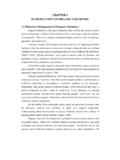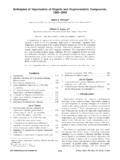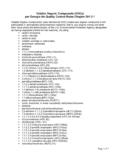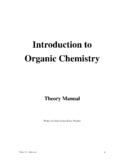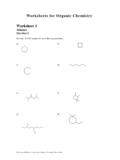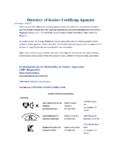Transcription of PERSISTENT ORGANIC POLLUTANTS ( POPs )
1 1 TRAINING FOR THE HEALTH SECTORTRAINING FOR THE HEALTH SECTOR[Date [Date ..Place Place .. ]Organizer] PERSISTENT ORGANIC PERSISTENT ORGANIC POLLUTANTS ( POLLUTANTS (POPsPOPs))Children's Health and the EnvironmentWHO Training Package for the Health SectorWorld Health 2008 version<<NOTE TO USER: Please add details of the date, time, place and sponsorship of the meeting for which you are using this presentation in the space indicated.>> <<NOTE TO USER: This is a large set of slides from which the presenter should select the most relevant ones to use in a specific presentation. These slides cover many facets of the problem. Present only those slides that apply most directly to the local situation in the region.
2 >>2 POPsPOPs To learn about POPs ( PERSISTENT ORGANIC POLLUTANTS ) and related substances To learn why and how POPs may affect children's health To identify gaps in knowledge and research needs To review international agreements and recommendations on POPs To discuss how health care providers and different stakeholders can take action to prevent exposureLEARNING OBJECTIVESLEARNING OBJECTIVES<<READ SLIDE.>> <<NOTE TO USER: Please add other objectives, if relevant, and refer to the situation of the country concerning the ratification of the Stockholm Convention and national implementation plans (NIPs).>>3 POPsPOPsWHAT ARE "POPs" ?
3 Syntheticorganic chemicals PERSISTENT in environment Long-range transport leads to global pollution Lipophilic Accumulate in food chain High levels in fish and marine mammalsAcute toxicity well characterizedAcute toxicity well characterizedNOAAThe POPs are: Synthetic (man-made) ORGANIC chemicals they are all synthetic chemicals, either intentionally or non-intentionally produced/released. Some are pesticides, others are industrial products or unintended by-products resulting from industrial processes or combustions (see next slide). PERSISTENT in the environment their persistence in the environment is remarkable it may take them decennia or centuries to be degraded.
4 Long-range transport leads to global pollution Some POPs will almost always be found if tested for in tissues or environmental samples from different parts of the world. As is the case with many environmental POLLUTANTS , it is most difficult to establish that illness or disease are directly attributable to exposure to a specific PERSISTENT ORGANIC pollutant or to a group of POPs. This difficulty is further underscored by (a) the fact that POPsrarely occur as a single compound, and (b) that individual field studies are insufficient to provide compelling evidence of cause and effect in their own right. Lipophilic they have a tendency to remain in fat-rich tissues.
5 This affinity for the adipose tissues means that POPs are likely to accumulate, persist and bioconcentrate and could, eventually, achieve toxicologically relevant concentrations even though exposure episodes may appear limited. Accumulate in food chain POPs enter into a cycle in nature, accumulating in the bigger animals as they eat the smaller ones. Highest levels found in marine mammals immune dysfunction is considered as a plausible cause for increased mortality among marine mammals. It is postulated that the consumption by seals of fish contaminated with POPs may lead to vitamin and thyroid deficiencies and cause increased susceptibility to microbial infections and reproductive disorders.
6 Acute, high-level toxicity is well characterized acute effects after high-level exposure have been described for some of the organochlorine pesticides ( aldrin, dieldrin and toxaphene). PCBs have caused well-documented episodes of mass poisoning called "Yusho" and "Yu Cheng , that occurred in China, Province of Taiwan, and in Japan. Pregnant women exposed had no or minor symptomatology, but their children presented adverse effects and developmental disorders. Some are potential endocrine disrupters this will be addressed later in the : above: NOAA, NURP, Wicklund. Humpback whales cruising beneath a diver. below: NOAA, Captain Budd Christman.
7 Humpback whale. CHEMICALSPCBsHCBUNINTENDED BYPRODUCTSD ibenzodioxinsDibenzofuransPERSISTENT ORGANIC POLLUTANTS (POPs)Stockholm Convention: a global treaty ratified by the international community lead by UNEP calls for the elimination and/or phasing out of 12 are the PERSISTENT ORGANIC POLLUTANTS grouped according to their use and origin:-8 pesticides Introduced in 1940-1950, banned later on but still in use in some industrial chemicals One of these, HCB, was used as a fungicide in the unintended industrial by-products.<<READ SLIDE.>>PCBs: polychlorinated biphenylsHCB: hexachlorocyclohexaneDDT: dichlorodiphenyl Stockholm Convention is a global treaty ratified by the international community and led by the United Nations Environment Programme (UNEP) that calls for the elimination and/or phasing out of 12 POPs, called the "dirty dozen".
8 More information is available at: : White, odourless, crystalline solid (pure); light tan colour with faint chemical odour for technical grade Heptachlor: White to light tan, waxy solid or crystals with a camphor-like odourMirex:White crystalline, odourless solid Toxaphene: Yellow, waxy solid w/ chlorine/terpene-like odourUNEP Endrin is a foliar insecticide used mainly on field crops such as cotton and grains. It has also been used as a rodenticide to control mice and voles. It is rapidly metabolized by animals and does not accumulate in fat to the same extent as other compounds with similar structures. It can enter the atmosphere by volatilization, and can contaminate surface water from soil run-off.
9 The half-life of endrin in soil may be up to 12 years, depending on local conditions. This persistence, combined with a high partition coefficient (log KOW = ), provides the necessary conditions for endrin to bioconcentrate in organisms. The chemical properties of endrin (low water solubility, high stability in the environment, and semi-volatility) favourits long-range transport, and it has been detected in arctic fresh water. The main source of endrin exposure to the general population is residues in food however, contemporary intake is generally below the acceptable daily intake of mg/kg body weight recommended by the Joint FAO/WHO Meeting on Pesticide Residues (JMPR).
10 Heptachlor is a non-systemic stomach and contact insecticide, used primarily against soil insects and termites. It has also been used against cotton insects, grasshoppers, some crop pests and to combat malaria. Heptachlor is highly insoluble in water, and is soluble in ORGANIC solvents. It is quite volatile and can be expected to partition into the atmosphere as a result. It binds readily to aquatic sediments and bioconcentrates in the fat of living organisms. The half-life of heptachlor in temperate soil is up to 2 years. This persistence, combined with a high partition coefficient (KOW = ), provides the necessary conditions for heptachlor to bioconcentrate in organisms.











